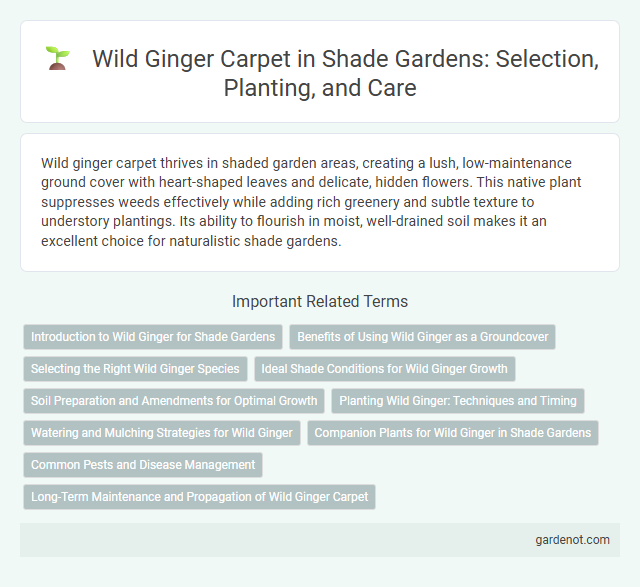Wild ginger carpet thrives in shaded garden areas, creating a lush, low-maintenance ground cover with heart-shaped leaves and delicate, hidden flowers. This native plant suppresses weeds effectively while adding rich greenery and subtle texture to understory plantings. Its ability to flourish in moist, well-drained soil makes it an excellent choice for naturalistic shade gardens.
Introduction to Wild Ginger for Shade Gardens
Wild ginger (Asarum canadense) thrives in shade gardens, offering a dense carpet of heart-shaped leaves that suppress weeds and retain moisture. This native perennial is ideal for understory planting, providing natural ground cover with attractive, though often overlooked, maroon-brown flowers that bloom in spring. Its low-maintenance growth habit and adaptability to moist, acidic soils make wild ginger a valuable choice for enhancing biodiversity and soil health in shaded garden areas.
Benefits of Using Wild Ginger as a Groundcover
Wild ginger carpet thrives in shade gardens, providing a dense, evergreen groundcover that suppresses weeds and retains soil moisture effectively. Its heart-shaped leaves create a natural mulch layer, reducing erosion and enhancing soil health over time. This low-maintenance plant supports biodiversity by attracting pollinators while thriving in low-light conditions.
Selecting the Right Wild Ginger Species
Selecting the right wild ginger species for a shade garden depends on factors such as climate zone, soil type, and moisture levels. Asarum canadense thrives in moist, loamy soils of USDA zones 3-8, while Asarum europaeum prefers well-drained, slightly acidic soils in zones 5-7. For optimal ground cover, choose species with dense, evergreen foliage like Asarum splendens to ensure year-round shade garden interest.
Ideal Shade Conditions for Wild Ginger Growth
Wild ginger thrives best in deep, consistent shade, preferring environments with filtered sunlight beneath dense tree canopies or shrubs. Ideal shade conditions replicate its native forest understory habitat, maintaining moist, well-draining soil enriched with organic matter. Protecting wild ginger from direct afternoon sun preserves its vibrant foliage and encourages robust groundcover growth.
Soil Preparation and Amendments for Optimal Growth
Wild ginger thrives in rich, well-drained soil with a high organic matter content, making it ideal for shade garden carpets. Preparing the soil by incorporating compost or aged leaf mold enhances moisture retention and provides essential nutrients for optimal growth. Maintaining a slightly acidic to neutral pH range of 5.5 to 7 ensures wild ginger establishes robust roots and vibrant foliage.
Planting Wild Ginger: Techniques and Timing
Planting wild ginger (Asarum canadense) requires well-drained, rich, and consistently moist soil typically found in shaded woodland areas to mimic its natural habitat. The ideal timing for planting wild ginger is early spring or fall, allowing roots to establish before the growing season begins. Utilize root divisions or rhizome cuttings spaced 12 to 18 inches apart to create a dense carpet that suppresses weeds and enhances shade garden biodiversity.
Watering and Mulching Strategies for Wild Ginger
Wild ginger (Asarum canadense) thrives in moist, well-drained soil, benefiting from consistent watering that maintains soil dampness without waterlogging. Applying a 2-3 inch layer of organic mulch, such as shredded leaves or bark, conserves soil moisture, suppresses weeds, and moderates soil temperature for optimal root development. Regularly monitoring soil hydration levels ensures healthy growth and vibrant ground cover in shaded garden environments.
Companion Plants for Wild Ginger in Shade Gardens
Wild ginger (Asarum canadense) thrives in shade gardens when paired with companion plants like ferns, hostas, and trilliums, which share similar moisture and soil requirements. These companions enhance the woodland aesthetic and provide varying textures and heights, supporting a naturalistic planting scheme. Incorporating shade-tolerant groundcovers such as foamflower and Solomon's seal further complements wild ginger, creating a diverse and healthy shade garden ecosystem.
Common Pests and Disease Management
Wild ginger carpet (Asarum canadense) is typically resistant to many pests, but slug and snail infestations can damage its foliage, requiring regular monitoring and use of organic slug repellents. Powdery mildew may occasionally occur in humid conditions; ensuring good air circulation and avoiding overhead watering helps prevent fungal outbreaks. Applying natural fungicides and removing affected leaves promptly supports healthy growth and maintains the plant's dense, attractive ground cover in shade gardens.
Long-Term Maintenance and Propagation of Wild Ginger Carpet
Wild ginger carpet requires minimal long-term maintenance due to its evergreen foliage and natural pest resistance, thriving in well-drained, humus-rich shade soil with moderate moisture. Propagation is efficiently done through rhizome division in early spring or fall, ensuring healthy spread without disturbing established plants. Regular mulching and occasional pruning help sustain its dense ground cover appearance and prevent invasive growth.
Wild ginger carpet Infographic

 gardenot.com
gardenot.com